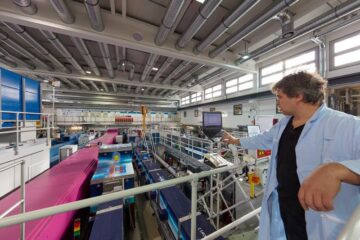“SiBiCos” – New Silica Biopolymer Hybridmaterials and Composites

Immobilisation of biomolecules and cells within polymer matrices has gained considerable importance in various fields of biotechnical processes. Such immobilised biomolecules are relevant in the field of red, green and white biotechnology.
The present invention relates in a first aspect to a coated polymer system comprising silica-coated polymer and functional components. Said coating of the polymer is obtained by using Si-N precursors having at least two amino groups and, in addition, coating is affected in the presence of the functional component (i.e. biomolecule). Beside the use of encapsulated functional components such as biologicals including catalytic antibodies, DNA, RNA, enzymes, antigens, life bacterial, fungal, plant and animal cells as well as whole protozoa for various uses in red and green biotechnology, bioencapsulation becomes more and more important in the field of white biotechnology. In addition, bioencapsulation may ensure sustained release as well as improved and extended activity of the encapsulated functional components. Moreover, other applications are considered in the field of optical and electrochemical technology, in diagnostic devices but also in the field of green biotechnology.
Weitere Informationen: PDF
PROvendis GmbH
Tel.: +49 (0)208/94105 10
Ansprechpartner
Dipl.-Ing. Alfred Schillert
Media Contact
Alle Nachrichten aus der Kategorie: Technologieangebote
Neueste Beiträge

Bakterien für klimaneutrale Chemikalien der Zukunft
Forschende an der ETH Zürich haben Bakterien im Labor so herangezüchtet, dass sie Methanol effizient verwerten können. Jetzt lässt sich der Stoffwechsel dieser Bakterien anzapfen, um wertvolle Produkte herzustellen, die…

Batterien: Heute die Materialien von morgen modellieren
Welche Faktoren bestimmen, wie schnell sich eine Batterie laden lässt? Dieser und weiteren Fragen gehen Forschende am Karlsruher Institut für Technologie (KIT) mit computergestützten Simulationen nach. Mikrostrukturmodelle tragen dazu bei,…

Porosität von Sedimentgestein mit Neutronen untersucht
Forschung am FRM II zu geologischen Lagerstätten. Dauerhafte unterirdische Lagerung von CO2 Poren so klein wie Bakterien Porenmessung mit Neutronen auf den Nanometer genau Ob Sedimentgesteine fossile Kohlenwasserstoffe speichern können…

















